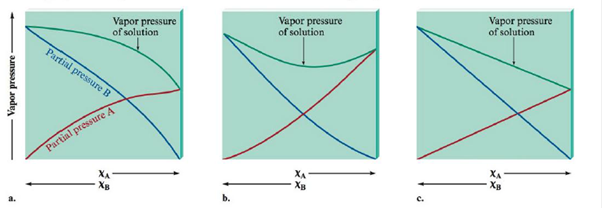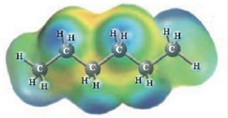
Concept explainers
Match the vapor pressure diagrams with the solute-solvent combinations and explain your answers.

a.  and
and 
b.  and
and 
c.  and
and 
d.  and
and 
(a)
Interpretation:
The dissolution of the given following solute and solvent has to be explained using Raoult’s law.
Concept Introduction: Concept introduction:
Raoult's law:
The mole fraction of a solute is related to the vapor pressure of the solution thus,
Answer to Problem 69E
A Negative deviations from Raoult’s law is the right option for Acetone-Water solution.
Explanation of Solution
To find the second diagram match with Acetone and Water
The second diagram illustrates negative variation from Raoult's law. This occurs whilst the solute-solvent connections are stronger than the connections in pure solvent and pure solute.
These two molecules are named Acetone (
(b)
Interpretation:
The dissolution of the given following solute and solvent has to be explained using Raoult’s law.
Concept Introduction: Concept introduction:
Raoult's law:
The mole fraction of a solute is related to the vapor pressure of the solution thus,
Answer to Problem 69E
A Positive deviation from Raoult’s law is the right option for Ethanol-Water solution.
Explanation of Solution
To find the first diagram match with
The first diagram shows positive deviation from Raoult's law. This occurs when the solute-solvent connections are weaker than the connections in pure solvent and pure solute.
These two molecules are named Ethanol (
(c)
Interpretation:
The dissolution of the given following solute and solvent has to be explained using Raoult’s law.
Concept Introduction: Concept introduction:
Raoult's law:
The mole fraction of a solute is related to the vapor pressure of the solution thus,
Answer to Problem 69E
No deviation from Raoult’s law is the correct choice for Heptane-Hexane. solution.
Explanation of Solution
To find the polarity of Heptane and Hexane
Heptane and Hexane
The third diagram illustrates an perfect solution with no difference from Raoult's law. This occurs what time the solute-solvent interactions are concerning equal to the pure solvent and pure solute interactions.
These two molecules are named Heptane (
(d)
Interpretation:
The dissolution of the given following solute and solvent has to be explained using Raoult’s law.
Concept Introduction: Concept introduction:
Raoult's law:
The mole fraction of a solute is related to the vapor pressure of the solution thus,
Answer to Problem 69E
Heptane and Water results in positive deviations from Raoult’s law (the first diagram).
Explanation of Solution
To find: The Heptane Vs Water.
These two molecules are named Heptane (
Want to see more full solutions like this?
Chapter 11 Solutions
Bundle: Chemistry, Loose-leaf Version, 10th + Enhanced Webassign Printed Access Card For Chemistry, Multi-term Courses
Additional Science Textbook Solutions
Physics of Everyday Phenomena
Physical Universe
Biology: Life on Earth with Physiology (11th Edition)
Fundamentals Of Thermodynamics
General, Organic, and Biological Chemistry - 4th edition
- Experiment 27 hates & Mechanisms of Reations Method I visual Clock Reaction A. Concentration effects on reaction Rates Iodine Run [I] mol/L [S₂082] | Time mo/L (SCC) 0.04 54.7 Log 1/ Time Temp Log [ ] 13,20] (time) / [I] 199 20.06 23.0 30.04 0.04 0.04 80.0 22.8 45 40.02 0.04 79.0 21.6 50.08 0.03 51.0 22.4 60-080-02 95.0 23.4 7 0.08 0-01 1970 23.4 8 0.08 0.04 16.1 22.6arrow_forward(15 pts) Consider the molecule B2H6. Generate a molecular orbital diagram but this time using a different approach that draws on your knowledge and ability to put concepts together. First use VSEPR or some other method to make sure you know the ground state structure of the molecule. Next, generate an MO diagram for BH2. Sketch the highest occupied and lowest unoccupied MOs of the BH2 fragment. These are called frontier orbitals. Now use these frontier orbitals as your basis set for producing LGO's for B2H6. Since the BH2 frontier orbitals become the LGOS, you will have to think about what is in the middle of the molecule and treat its basis as well. Do you arrive at the same qualitative MO diagram as is discussed in the book? Sketch the new highest occupied and lowest unoccupied MOs for the molecule (B2H6).arrow_forwardQ8: Propose an efficient synthesis of cyclopentene from cyclopentane.arrow_forward
- Q7: Use compound A-D, design two different ways to synthesize E. Which way is preferred? Please explain. CH3I ONa NaOCH 3 A B C D E OCH3arrow_forwardPredict major product(s) for the following reactions. Note the mechanism(s) of the reactions (SN1, E1, SN2 or E2).arrow_forward(10 pts) The density of metallic copper is 8.92 g cm³. The structure of this metal is cubic close-packed. What is the atomic radius of copper in copper metal?arrow_forward
- Predict major product(s) for the following reactions. Note the mechanism(s) of the reactions (SN1, E1, SN2 or E2).arrow_forwardPredict major product(s) for the following reactions. Note the mechanism(s) of the reactions (SN1, E1, SN2 or E2).arrow_forwardQ3: Rank the following compounds in increasing reactivity of E1 and E2 eliminations, respectively. Br ca. go do A CI CI B C CI Darrow_forward
- Q5: Predict major product(s) for the following reactions. Note the mechanism(s) of the reactions (SN1, E1, SN2 or E2). H₂O דיי "Br KN3 CH3CH2OH NaNH2 NH3 Page 3 of 6 Chem 0310 Organic Chemistry 1 HW Problem Sets CI Br excess NaOCH 3 CH3OH Br KOC(CH3)3 DuckDuckGarrow_forwardQ4: Circle the substrate that gives a single alkene product in a E2 elimination. CI CI Br Brarrow_forwardPlease calculate the chemical shift of each protonsarrow_forward
 Chemistry: An Atoms First ApproachChemistryISBN:9781305079243Author:Steven S. Zumdahl, Susan A. ZumdahlPublisher:Cengage Learning
Chemistry: An Atoms First ApproachChemistryISBN:9781305079243Author:Steven S. Zumdahl, Susan A. ZumdahlPublisher:Cengage Learning
 ChemistryChemistryISBN:9781305957404Author:Steven S. Zumdahl, Susan A. Zumdahl, Donald J. DeCostePublisher:Cengage Learning
ChemistryChemistryISBN:9781305957404Author:Steven S. Zumdahl, Susan A. Zumdahl, Donald J. DeCostePublisher:Cengage Learning- Chemistry: Matter and ChangeChemistryISBN:9780078746376Author:Dinah Zike, Laurel Dingrando, Nicholas Hainen, Cheryl WistromPublisher:Glencoe/McGraw-Hill School Pub Co
 Introductory Chemistry: An Active Learning Approa...ChemistryISBN:9781305079250Author:Mark S. Cracolice, Ed PetersPublisher:Cengage Learning
Introductory Chemistry: An Active Learning Approa...ChemistryISBN:9781305079250Author:Mark S. Cracolice, Ed PetersPublisher:Cengage Learning Chemistry: Principles and PracticeChemistryISBN:9780534420123Author:Daniel L. Reger, Scott R. Goode, David W. Ball, Edward MercerPublisher:Cengage Learning
Chemistry: Principles and PracticeChemistryISBN:9780534420123Author:Daniel L. Reger, Scott R. Goode, David W. Ball, Edward MercerPublisher:Cengage Learning





